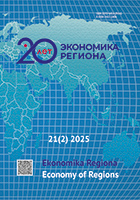Internal Migration in Kaliningrad Oblast: New and Old Tendencies
DOI:
https://doi.org/10.17059/ekon.reg.2025-2-18Keywords:
internal migration, rural-urban migration, migration ties, municipalities, spatial features, periphery, center, agglomeration, migration connectivity, Kaliningrad OblastAbstract
Internal migration in Kaliningrad Oblast has become a key factor for the region’s balanced development amid declining net migration from outside its borders. In recent years, internal migration patterns have shifted significantly due to socio-economic disparities among districts. Both the volume and geographic structure of migration flows between districts and settlements have undergone transformation. This study aims to identify and explain the changes in internal migration dynamics in 2020–2023 compared to the earlier period of 2011–2019. The analysis employs general scientific and statistical methods, typology, as well as sociological and cartographic approaches. The analysis draws on official migration statistics from Kaliningradstat (the regional statistical agency) covering municipal, rural, and urban areas, as well as data from a population survey on migration intentions conducted in March–April 2024. The results indicate a trend toward population concentration in the regional center and suburbanization in the western part of the region. These patterns are driven by a combination of motivations to improve quality of life and increased economic and investment activity around the regional capital. While rural-to-urban migration and broader urbanization trends persist, they are now more pronounced in the eastern districts, whereas the influx into the Kaliningrad agglomeration has notably slowed. This shift is primarily attributed to the effects of the “poverty trap.” Additionally, transit migration has emerged across the outer suburban belt and the rapidly developing Guryevsky District, facilitated by improved transport accessibility and smaller cost-of-living differentials compared to peripheral areas. Nonetheless, it is premature to conclude that these observed transformations represent a completed shift toward a new internal migration regime in the region.
Downloads
Published
How to Cite
Issue
Section
License
Copyright (c) 2025 Лялина Анна Валентиновна , Гуменюк Иван Сергеевич , Плотникова Ангелина Петровна

This work is licensed under a Creative Commons Attribution 4.0 International License.




